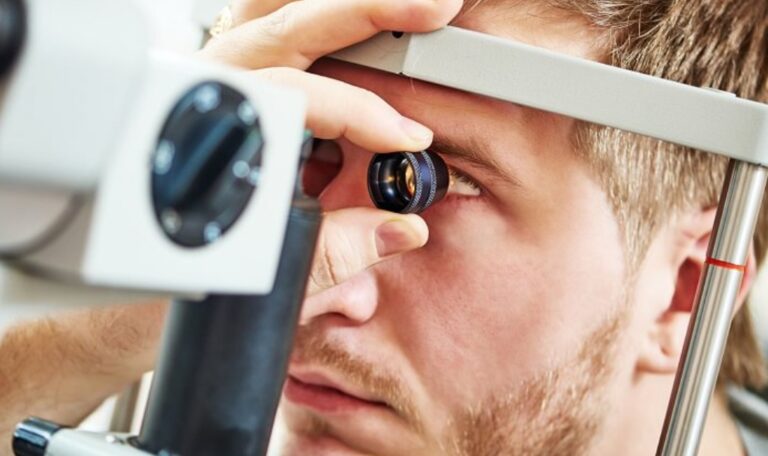Astigmatism is a kind of visual defect that occurs due to refractive errors resulting from irregularities in the shape of the cornea. The scientific reason for this disease is that the eyes cannot focus on one point. And the light on the retina does not focus on a single point, which leads to blurred or distorted vision.
Actually this case can be present from birth and may develop gradually with age. Also This condition is common and can be easily diagnosed with a simple eye exam.
Furthermore astigmatism is a refractive error and not an eye disease or eye health problem.
Symptoms of astigmatism
It usually appears at any distance to the eye’s vision and leads to blurry or distorted image, also patients could suffer from eye strain, headache, squint, and eye irritation.
what causes astigmatism ?
The man reason is the irregular shape of the cornea. The Shape of cornea is like an egg (or rugby ball) rather than a symmetrical ball (like a soccer ball), and one of the meridians is much more curved than the meridian is perpendicular to it.
The meridian with the strongest curvature and the meridian with the weakest curvature called the main meridian.
In some cases, the crystalline lens distortion causes That disease. This is called crystalline to distinguish it from the more common corneal astigmatism. Any parent should get their kids eye examination to avoid low vision due to uncorrected astigmatism at school.
3 Main Types
Myopia
Which means that one or both of the major meridians of the eye have myopia or nearsightedness.
Farsighted
In this type one or both of the major meridians of the eye is hyperopia which makes the patient feel that he couldn’t see the near objects clearly.
Mixed
This type has one of the major lines of longitude is myopia and the other is hyperopia.
It can also be classified as normal or irregular . In the case of normal , the prime meridians are 90 ° apart, and in irregular , the main meridian is not vertical.
Most of the diseaseis the normal corneal , and has an oval shape in front of the eye.
The causes of irregular type due to its different types may arise from eye surgeries, eye damage that causes scarring on the cornea.
Or there is keratoconus, a disease in which the cornea becomes gradually thinner.
Diagnosing
The same equipment and techniques that are used in examining nearsightedness (myopia) and farsightedness (hyperopia).
It is detected with a regular eye exam, in which the doctor places a lens with a pad in front of the patients’ eyes and illuminates their eyes to reduce the amount of the diseaseis.
The test is called the imaging method.
Astigmatism Correction Options
Astigmatism can usually be corrected with eyeglasses or contact lenses.
One of the least common options for correcting astigmatism is refractive surgery, but it carries the risks of most surgeries because laser surgery changes the shape of the eye.
Astigmatism rates vary over time and may require prescription changes, so once diagnosed, go to an eye care professional to review them frequently.
Degrees of astigmatism in numbers
The simple: in which the two axes of the cornea bring a focus of an image on the retina, while the other axis brings it in front or behind the retina, and this is not related to myopia or farsightedness.
And there is irregular regular astigmatism and patients develop short-sightedness or long-sightedness.
if we assume that the two main axes of the image are in two foci in front of the retina, then the patient suffers from myopia and suffers from negative astigmatism.
But if the two main axes of the image are in two foci behind the retina, he will suffer From farsightedness and astigmatism to positive.
Combined or mixed regular astigmatism: In this case, one of the two main axes brings the focus of the image in front of the retina and the other brings it behind the retina.
Or in other words, the nearsighted will suffer from astigmatism with a positive sign, while the farsighted patient will suffer from astigmatism with a negative sign.
Irregular astigmatism: arises from corneal fasteners or keratoconus, and in this case there must be certain medical measurements to know its axis and degree of astigmatism.
how to correct astigmatism

Medical glasses.
- Contact lenses whether soft or hard.
- Surgical methods whether laser operations, intraocular lens replacement, or corneal transplantation.
- Laser surgery is a popular treatment for low vision all over the world.
- Patients who have reached the age of 18 and have stable visual defects for more than a year are eligible.
In addition, there should be no other diseases that affect the eye even indirectly.
After a detailed examination, the ophthalmologist must decide which of the laser procedures is appropriate for the patient. - The other procedure is a lens inside the eyeball after removing the main lens of your eye.
- The artificial correction lens compensates for astigmatism while making sure that the cornea remains intact.
This treatment method is also recommended for highly pronounced astigmatism and it’s the last option.
In this relatively radical method, the ophthalmologist removes the patient’s cornea and implants the active cornea from a donor.
Laser operations to correct astigmatism
- PRk Simple Laser.
- LASEK keratoplasty.
- Femto-Lasik process.
- Z-lasik (laser corneal correction).
- Femto Smile process.
What are the advantages of laser eye surgery?
Painless surgery.
- The patient is sitting under local anesthesia.
- The duration of the operation is about only 10-15 minutes.
- Fast recovery.
- Full vision after a few days or weeks (depending on the type of operation).
How to fix astigmatism with lenses?
Specialists use toric lenses and glasses to keep eye rotation to a minimum, and toric lenses also have special stabilizing properties.


